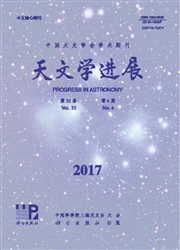

 中文摘要:
中文摘要:
综述了大小麦哲伦云在紫外、可见光和红外波段的消光规律及其2D消光图,并讨论了其尘埃的性质。大麦哲伦云(LMC)可见光波段的平均色余E(B-V)约为0.13 mag,其RV一般取2.6,AV约为0.34 mag。小麦哲伦云(SMC)可见光波段的平均色余E(B-V)约为0.16mag,其RV一般取2.8,AV约为0.45 mag。从紫外消光的区域性变化来看,LMC的恒星形成区30Dor和LMC2超大气体壳层区属于比较致密的区域,都缺乏2175驼峰,消光在紫外上升比较快;但LMC中相对弥漫的区域却有比较明显的2175消光驼峰。SMC的bar区域几乎看不到2175驼峰,消光在紫外陡峭地上升;而wing区域则有较强的2175驼峰,消光在紫外上升的趋势也较缓。在红外波段,LMC的E(J-H)/E(H-K)大致在1.03~1.36之间,显著低于银河系的典型值1.73,说明LMC近红外消光律的幂律谱指数是明显小于银河系的;SMC的红外消光很小,测光和內禀色指数的微小误差都会带来较大不确定性,目前还没有一致的结论。总之,LMC和SMC的消光曲线不能简单地像银河系消光曲线那样,用仅含单参量RV的理论曲线来描述,而是需要适合其自身的尘埃模型以描述其消光规律。
 英文摘要:
英文摘要:
We review the extinction laws of the Magellanic Clouds(MCs) from the ultraviolet(UV), optical to infrared and the 2D extinction maps of the MCs. The dust properties of the MCs are also discussed. The color excess E(B- V) of the Large Magellanic Cloud(LMC) is about 0.13 mag. If RV= 2.6 is adopted, the AVvalue is about 0.34 mag. The color excess E(B-V) of the Small Magellanic Cloud(SMC) is about 0.16 mag, which corresponds to an AVof about 0.45 mag(for RV= 2.8). The star formation regions LMC 30 Dor and Super Shell LMC 2 could be considered as relatively dense regions. They both lack the 2175 extinction bump feature and their extinction rises steeply in the UV range, while in the diffuse regions of LMC, the 2175 bump is relatively strong. As for the SMC, the 2175 bump is absent in the SMC bar region, and the extinction rises even more steeply in the UV band, while in the SMC wing region, the 2175 bump feature is present. In the infrared band, the ratio of the color excess E(J- H)/E(H- K) is roughly between 1.03 and 1.36 for LMC, clearly lower than the ratio of the Milky Way that is about 1.73. In SMC, the infrared extinction is fairly small, and as a tiny error of photometry or intrinsic color will bring large uncertainty, there is no consistent conclusion yet. The extinction curves of the LMC and SMC can not be described by the simple CCM parameterization containing a single parameter RVwhich is valid for the Milky Way. By fitting the extinction curve as well as the infrared radiation of the Magellanic Clouds, it is found that the carbonaceous dust grains,compared to the silicate dust, are less abundant than those in the Milky Way. In particular,the lack of small carbonaceous dust grains is suggested to explain the weakness of the 2175 bump in the star-forming regions where the UV photons may destroy the very small carrier like graphite or PAH molecules. The dust-to-gas ratio in the MCs is significantly lower than that in the Milky Way very possibly due to th
 同期刊论文项目
同期刊论文项目
 同项目期刊论文
同项目期刊论文
 ON IRON MONOXIDE NANOPARTICLES AS A CARRIER OF THE MYSTERIOUS 21 mu m EMISSION FEATURE IN POST-ASYMP
ON IRON MONOXIDE NANOPARTICLES AS A CARRIER OF THE MYSTERIOUS 21 mu m EMISSION FEATURE IN POST-ASYMP 期刊信息
期刊信息
